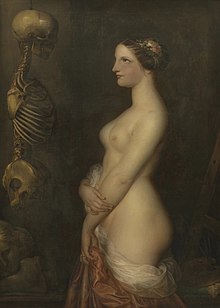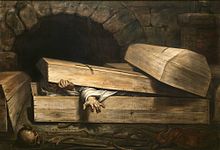Antoine Joseph Wiertz
Antoine Joseph Wiertz (born February 22, 1806 in Dinant , † June 18, 1865 in Ixelles near Brussels ) was a Belgian painter, draftsman and engraver.
Even as a schoolboy, Wiertz was noticed for his artistic talent. Through the mediation of his teachers, Wiertz was accepted as a student in Antwerp by the painters Willem Jacob Herreyns and Mathieu Ignace van Brée in 1820 at the age of 14 . In the following year he was granted a lifelong honorary salary by the Dutch King Wilhelm I.
Twelve years later, on the occasion of an exhibition at the Paris Salon in 1832 , Wiertz won the Prix de Rome , which was financed from a five-year travel grant. In the spring of 1833 Wiertz started his study trip to and through Italy. In Rome he studied the ancient masters and was also influenced by Michelangelo and Peter Paul Rubens .
In the years 1835/36 Wiertz created his monumental painting Battle of the Greeks and Troians for the corpse of Patroclus in Rome . In this work Wiertz tried for the first time to realize his artistic ideal. In 1838 he returned to his homeland and settled in Liège as a freelance painter. Wiertz earned his living with portraits and genre pieces , but these interested him so little that he signed very few of them.
His interest at this time was the realization of his work The Raising of Hell against Heaven , which was to be even more gigantic than his Roman monumental painting. For reasons of space, Wiertz opened his studio in a secularized church and the triptych Christ in the Grave , Eve and Satan and The Flight into Egypt was created as a preliminary exercise .
When the city of Antwerp also invited Wiertz to attend an art exhibition in 1840 , he won first prize with his work Eloge de Rubens . In 1848 he settled in Brussels, where he was able to complete his major work The Triumph of Christ that same year . One of his greatest admirers was the Belgian King Leopold I , who also supported him financially.
At the request of the king, Wiertz was built a large studio in Ixelles near Brussels in 1850 at state expense. Wiertz personally designed the construction plans, because this studio was specially designed for his gigantic paintings. The building remained the property of Wiertz until the end of his life, but was returned to Belgium in his will after his death.
In this studio, Wiertz experimented with new types of colors and their painting techniques and repeatedly endangered his health. In doing so, he invented the “peinture mate”, a method of painting that enabled him to achieve the matt color effect of a fresco using a conventional canvas as a background . With this new method, Wiertz tried to give shape to his ideas. According to his own statements, Wiertz wanted to hold up a mirror to society with his works.
Wiertz addressed his philosophy and found his subjects in his fantasies, dreams and visions. In the opinion of the official art critic, he very often exceeded the limits of good taste; Controversial discussions were therefore the order of the day with many of the pictures. Some of the most important paintings from this period are The Buried Alive , Hunger, Madness and Crime , The Suicide , Thoughts and Visions of the Head of an Executed Man, and the like. v. a.
In addition to these paintings in Peinture mate , Wiertz also devoted himself to genre painting , treating similar bizarre subjects: The burned child , the novelist and the devil , the young witch and the like. a. In a few pictures of his work, such as A Young Girl at the Toilet , The Expectation , The Confession or The Rosebud , Wiertz also shows amiable humor.
Wiertz created various preliminary studies and detailed views of many of his paintings, which he occasionally engraved in copper himself.
The painter Antoine Wiertz died on June 18, 1865 in Brussels at the age of 59. After his death, the Kingdom of Belgium inherited all of his artistic work, including his studio. Redesigned as the Musée Wiertz , the works of Antoine Joseph Wiertz can be viewed there.
Works (selection)
- Battle of the Greeks and Troians for the body of Patroclus (1835/36)
- The Elevation of Hell against Heaven (1842)
- Triptych: Christ in the grave. Eve and Satan , The Flight into Egypt
- The Triumph of Christ (1848)
- The Calvary Lighthouse
- Christ and the struggle of the parties
- Thoughts and visions of the head of an executed man
- The suicide
- The buried alive ( L'inhumation précipitée )
- Hunger, madness and crime
- The burned child
- The novelist and the devil
- The young witch
- A young girl at the toilet
- The expectation
- The confession
- The rosebud
literature
- Antoine J. Wiertz: Painting recipes. In: Art Chronicle. the supplement to the magazine for visual arts. Seemann, Leipzig vol. 4 (1869), p. 9 ff.
- Louis Labarre: Antoine Wiertz. Muquardt, Brussels 1867.
- Julius Potvin: Antoine Wiertz (1806–1865) , self-published, Brussels 1913.
- Fritz R. Vanderpyl: Antoine Wiertz . Cahiers de Belgique, Brussels 1931.
Web links
| personal data | |
|---|---|
| SURNAME | Wiertz, Antoine Joseph |
| ALTERNATIVE NAMES | Wiertz, Antoine |
| BRIEF DESCRIPTION | Belgian painter, draftsman and engraver |
| DATE OF BIRTH | February 22, 1806 |
| PLACE OF BIRTH | Dinant |
| DATE OF DEATH | June 18, 1865 |
| Place of death | Brussels |



